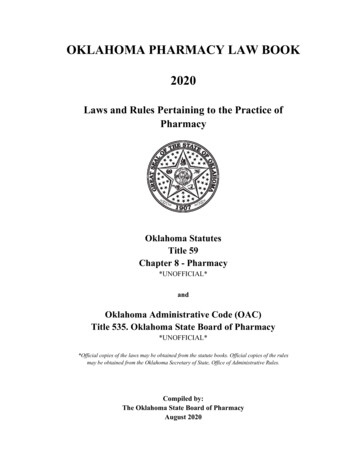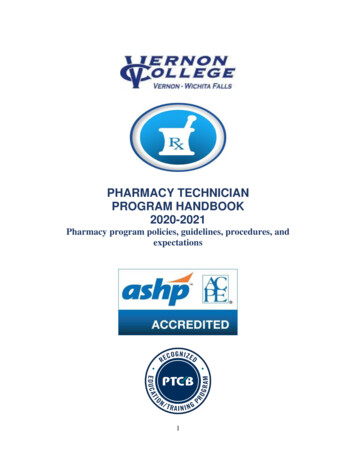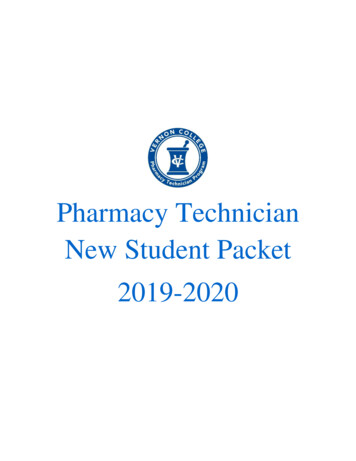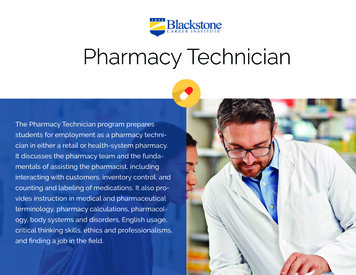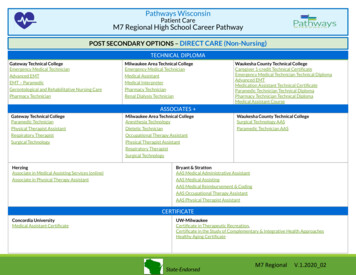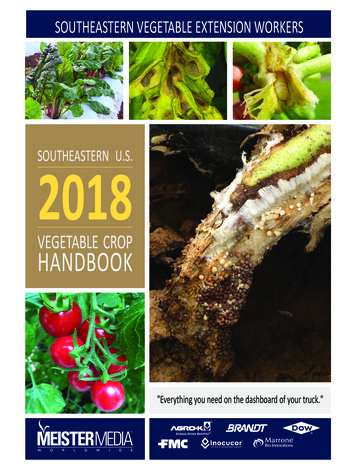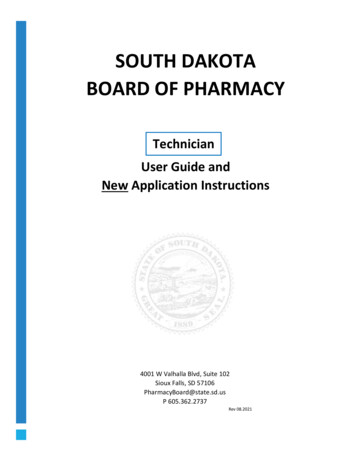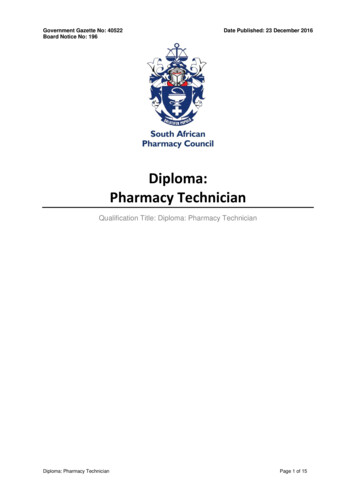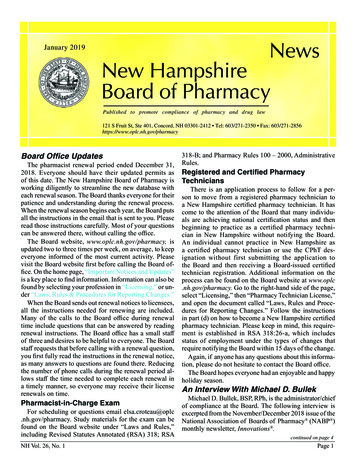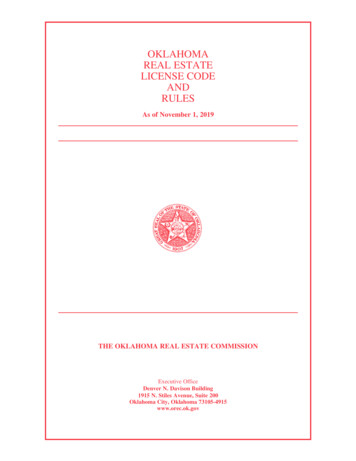
Transcription
PharmacyTechnicianStudy GuideAssessment:8616 Pharmacy TechnicianAligned with the PharmacyTechnician CertificationBoard and the NationalPharmacy TechnicianAssociation
OverviewThis study guide is designed to help students prepare for the Pharmacy Technician assessment. It notonly includes information about the assessment, but also the skills standards upon which the assessmentis based and test taking strategies.Each of the four sections in this guide provides useful information for students preparing for thePharmacy Technician assessment. CareerTech and Competency-Based Education: A Winning Combination Pharmacy Technician assessment Assessment Information Abbreviations and acronyms used in the study guide and assessment Standards and Test Content Sample Questions Strategies for Test Taking Success NotesThis assessment is aligned with the Pharmacy Technician Certification Board (PTCB) and the NationalPharmacy Technician Association (NPTA).For more information on the PTCB, please go to www.ptcb.org.Information about the NPTA can be found at www.pharmacytechnician.org.DisclaimerThe Oklahoma Department of Career and Technology Education cannot vouch for the accuracy of theinformation contained in any linked site. Our intent is to simply provide a list of sites that we feel maybe useful to you. Some of the links presented here are commercial sites. We do not endorse these sitesor their products, and we do not request or accept any fee for inclusion on this list. The Departmentmakes no representations or warranties, express or implied, with respect to the document, or anypart thereof, including any warrantees of title, noninfringement of copyright or patent rights of others,merchantability, or fitness or suitability for any purpose.Equal Opportunity/Non Discrimination StatementThe Oklahoma Department of Career and Technology Education does not discriminate on the basis ofrace, color, national origin, sex/gender, age, disability, or veteran status. Inquiries concerning applicationof this policy may be referred to the ODCTE Compliance Coordinator, 1500 W. 7th Ave. Stillwater, OK74074-4364, or call 1-800 522-5810 or (405) 377-2000.2
CareerTech and Competency-Based Education:A Winning CombinationCompetency-based education uses learning outcomes that emphasize both the application and creationof knowledge and the mastery of skills critical for success. In a competency-based education system,students advance upon mastery of competencies, which are measurable, transferable outcomes thatempower students.Career and technology education uses industry professionals and certification standards to identifythe knowledge and skills needed to master an occupation. This input provides the foundation fordevelopment of curriculum, assessments and other instructional materials needed to prepare studentsfor wealth-generating occupations and produce comprehensively trained, highly skilled employeesdemanded by the work force.Tools for SuccessCareerTech education relies on three basic instructional components to deliver competency-basedinstruction: skills standards, curriculum materials, and competency assessments.Skills standards provide the foundation for competency-based instruction and outline theknowledge and skills that must be mastered in order to perform related jobs within an industry. Skillsstandards are aligned with national skills standards and/or industry certification requirements; therefore,a student trained to the skills standards is equally employable in local, state and national job markets.Curriculum materials and textbooks contain information and activities that teach studentsthe knowledge and skills outlined in the skills standards. In addition to complementing classroominstruction, curriculum resources include supplemental activities that enhance learning by providingopportunities to apply knowledge and demonstrate skills.Competency Assessments test the student over material outlined in the skills standards andtaught using the curriculum materials and textbooks. When used with classroom performanceevaluations, written competency assessments provide a means of measuring occupational readiness.Each of these components satisfies a unique purpose in competency-based education and reinforces theknowledge and skills students need to gain employment and succeed on the job.Measuring SuccessEvaluation is an important component of competency-based education. Pre-training assessmentsmeasure the student's existing knowledge prior to receiving instruction and ensure the student'straining builds upon this knowledge base. Formative assessments administered throughout the trainingprocess provide a means of continuously monitoring the student's progress towards mastery.Written competency assessments provide a means of evaluating the student's mastery of knowledgeand skills. Coaching reports communicate competency assessment scores to students and providea breakdown of assessment results by standard area. The coaching report also shows how wellthe student has mastered skills needed to perform major job functions and identifies areas of jobresponsibility that may require additional instruction and/or training.3
Pharmacy TechnicianAssessment InformationWhat is the Pharmacy Technician assessment?The Pharmacy Technician assessment is an end-of-program assessment for students who havecompleted a Pharmacy Technician program. The assessment provides an indication of student masteryof knowledge and skills needed to succeed as a pharmacy technician.How was the assessment developed?The assessment was developed by the CareerTech Testing Center. Items were developed and reviewed bya committee of subject matter experts.What does the assessment cover?The assessment is aligned to the PTCB and the NPTA. Specifically, the test includes 80 multiple-choicetest items.Pharmacology for TechniciansPharmacy Law and RegulationsSterile and Non-Sterile CompoundingMedication SafetyPharmacy Quality Assurance14%15%9%14%8%Medication Order Entry and Fill ProcessPharmacy Inventory ManagementPharmacy Billing and ReimbursementPharmacy Information System Usageand Application18%9%9%9%What are the benefits of using the assessment?Students receive a competency certificate for each assessment that he/she passes. This certificate maybe included in his/her portfolio and used to communicate the student’s mastery of the subject matter topotential employers.When should the assessment be taken?The CareerTech Testing Center recommends that students take this assessment as soon as possibleafter receiving all standards-related instruction, rather than waiting until the end of the school year.Is the assessment timed?No. Although students may take as long as they need, most finish the assessment within one hour.What resources can students use on the assessment?Students are allowed to use calculators and scratch paper on CTTC competency assessments; however,these items must be provided by the testing proctor and returned to the proctor before the student’sexam is submitted for scoring. Calculator apps on cell phones and other devices may not be used onthese assessments.4
What accommodations can be made for students withIndividualized Education Plans (IEPs)?Accommodations are allowed for students with an Individualized Education Plan. Examples of allowableaccommodations include: Extended time — This assessment is not timed; therefore, students may take as much time asneeded to finish. The assessment must be completed in one testing session. Readers — A reader may be used to read the assessment to a student who has been identified asneeding this accommodation. Enlarged text — Students needing this accommodation can activate this feature by clicking theicon in the upper right corner of the screen.What can students expect on Test Day?All CTTC assessments are web-based and delivered exclusively by a proctor in the school’s assessmentcenter. The proctor cannot be an instructor or anyone who was involved with the student duringinstruction.Assessments are delivered in a question-by-question format. When a question is presented, the studentcan select a response or leave the question unanswered and advance to the next question. Studentsmay also flag questions to revisit before the test is scored. All questions must be answered before thetest can be submitted for scoring.Can students retake the test?Students may retake the test unless their school or state testing policies prohibit retesting. Studentswho can retest must wait at least three days between test attempts.5
Standards and Test ContentDuty 1. Pharmacology for Technicians (11 questions)1. Generic and brand names of pharmaceuticals.2. Therapeutic equivalence.3. Drug interactions (e.g., drug-disease, drug-drug, drug-dietary supplement, drugOTC, drug-laboratory, drug-nutrient).4. Strengths/dose, dosage forms, physical appearance, routes of administration, andduration of drug therapy.5. Common and severe side or adverse effects, allergies, and therapeuticcontraindications associated with medications.6. Dosage and indication of legend, OTC medications, herbal and dietarysupplements.Duty 2. Pharmacy Law and Regulations (10 questions)1. Storage, handling and disposal of hazardous substances and wastes (e.g., MSDS).2. Hazardous substances exposure, prevention and treatment (e.g., eyewash, spillkit, MSDS).3. Controlled substance transfer regulations (DEA).4. Controlled substance documentation requirements for receiving, ordering, returning, loss/theft,destruction (DEA).5. Formula to verify the validity of a prescriber’s DEA number (DEA).6. Record keeping, documentation, and record retention (e.g., length of time prescriptions aremaintained on file).7. Restricted drug programs and related prescription-processing requirements (e.g., thalidomide,isotretinoin, clozapine).8. Professional standards related to data integrity, security, and confidentiality (e.g., HIPAA, backing upand archiving).9. Requirement for consultation (e.g., OBRA ’90).10. FDA’s recall classification.11. Infection control standards (e.g., laminar air flow, clean room, hand washing, cleaning counting trays,countertop, and equipment) (OSHA, USP 795 and 797).12. Record keeping for repackaged and recalled products and supplies (TJC, BOP).13. Professional standards regarding the roles and responsibilities of pharmacists, pharmacy technicians,and other pharmacy employees (TJC, BOP).14. Reconciliation between state and federal laws and regulations.15. Facility, equipment, and supply requirements (e.g., space requirements, prescription file storage,cleanliness, reference materials) (TJC, USP, BOP).6
Duty 3. Sterile and Non-Sterile Compounding (7 questions)1. Infection control (e.g., hand washing, PPE).2. Handling and disposal requirements (e.g., receptacles, waste streams).3. Documentation (e.g., batch preparation, compounding record).4. Determine product stability (e.g., beyond use dating, signs of incompatibility).5. Selection and use of equipment and supplies.6. Sterile compounding processes.7. Non-sterile compounding processes.Duty 4. Medication Safety (11 questions)1. Error prevention strategies for data entry (e.g., prescription ormedication order to correct patient).2. Patient package insert and medication guide requirements (e.g.,special directions and precautions).3. Identify issues that require pharmacist intervention (e.g., DUR,ADE, OTC recommendation, therapeutic substitution, misuse,missed dose).4. Look-alike/sound-alike medications.5. High-alert/risk medications.6. Common safety strategies (e.g., tall man lettering, separatinginventory, leading and trailing zeros, limit use of error prone abbreviations).Duty 5. Pharmacy Quality Assurance (6 questions)1. Quality assurance practices for medication and inventory control systems (e.g., matching NationalDrug Code (NDC) number, bar code, data entry).2. Infection control procedures and documentation (e.g., PPE, needle recapping).3. Risk management guidelines and regulations (e.g., error prevention strategies).4. Communication channels necessary to ensure appropriate follow-up and problem resolution (e.g.,product recalls, shortages).5. Productivity, efficiency, and customer satisfaction measures.6. Common safety strategies (e.g., tall man lettering, separating inventory, leading and trailing zeros,limit use of error prone abbreviations).7
Duty 6. Medication Order Entry and Fill Process (14 questions)1. Order entry process.2. Intake, interpretation, and data entry.3. Calculate doses required.4. Fill process (e.g., select appropriate product, apply special handling requirements, measure, andprepare product for final check).5. Labeling requirements (e.g., auxiliary and warning labels,expiration date, patient specific information).6. Packaging requirements (e.g., type of bags, syringes, glass,pvc, child resistant, light resistant).7. Dispensing process (e.g., validation, documentation anddistribution).Duty 7. Pharmacy InventoryManagement (7 questions)1. Function and application of NDC, lot numbers andexpiration dates.2. Formulary or approved/preferred product list.3. Ordering and receiving processes (e.g., maintain par levels, rotate stock).4. Storage requirements (e.g., refrigeration, freezer, warmer).5. Removal (e.g., recalls, returns, outdates, reverse distribution).Duty 8. Pharmacy Billing and Reimbursement (7 questions)1. Reimbursement policies and plans (e.g., HMOs, PPO, CMS, private plans).2. Third party resolution (e.g., prior authorization, rejected claims, plan limitations).3. Third-party reimbursement systems (e.g., PBM, medication assistance programs, coupons, and self-pay).4. Healthcare reimbursement systems (e.g., home health, long-term care, home infusion).5. Coordination of benefits.Duty 9. P harmacy Information System Usage and Application(7 questions)1. Pharmacy-related computer applications for documenting the dispensing of prescriptions.2. Databases, pharmacy computer applications, and documentation management (e.g., user access, drugdatabase, interface, inventory report, usage reports, override reports, diversion reports).8
Sample Questions 1. On a written prescription, what does NKDA stand for?a. no known drug allergyb. no health insurancec. no current prescriptionsd. no over the counter prescriptions 2. A prescription is filled for eye drops with the directions 2gtt od tid. How many dropswill a patient use a day?a. 4b. 6c. 8d. 12 3. A prescription is written for Lipitor 10mg 1 po qd with 11 refills. The pharmacy hasa 15% mark-up plus a 4.50 dispensing fee. The cost for a 90-count bottle is 233.15.How much is a 30-day supply?a.b.c.d. 4. A compound is prescribed containing nystatin and hydrocortisone with a 2:1 ratio. If thepharmacy technician fills a prescription for 3 oz, how much nystatin is needed?a.b.c.d. 82.22 93.87 94.55 95.1615g30g45g60g5. If federal law requires pharmacy records to be kept for two years and state lawrequires pharmacy records to be kept for five years. How long should the Oklahomapharmacies retain pharmacy records?a.b.c.d.two years - federal law supersedes state lawtwo years - the less stringent law applies to record retentionfive years - state law supersedes federal lawfive years - the more stringent law applies to records retention9
6. A prescription is written for Boniva 150mg 1tab po qhs monthly for one year. Whyshould the pharmacy technician question this prescription?a.b.c.d. 7. How many kilograms equal 60 lbs?a.b.c.d. 17.17232627.278. A common side effect of narcotics is:a.b.c.d. it does not come in the strength indicatedit should be taken in the morningthe prescription is only good for a 6-month supplynothing is wrong the prescription should be filled as writtenconstipation.diarrhea.increased respirations.insomnia.9. MSO4 is the abbreviation for:a.b.c.d.morphine sulfate.magnesium sulfate.magnesium sulfite.morphine sulfite. 10. When washing hands, the pharmacy technician must:a.b.c.d.apply hand sanitizer.scrub vigorously with foaming soap.use an approved anti-microbial cleanser.use hot water.10
Sample Questions — Key1. On a written prescription, what does NKDA stand for?a.b.c.d.no known drug allergyno health insuranceno current prescriptionsno over the counter prescriptionsCorrectIncorrectIncorrectIncorrect2. A prescription is filled for eye drops with the directions 2gtt od tid. How many drops will a patientuse a t3. A prescription is written for Lipitor 10mg 1 po qd with 11 refills. The pharmacy has a 15% markup plus a 4.50 dispensing fee. The cost for a 90-count bottle is 233.15. How much is a 30-daysupply?a.b.c.d. 82.22 93.87 94.55 95.16IncorrectCorrectIncorrectIncorrect4. A compound is prescribed containing nystatin and hydrocortisone with a 2:1 ratio. If the pharmacytechnician fills a prescription for 3 oz, how much nystatin is rectCorrect5. If federal law requires pharmacy records to be kept for two years and state law requires pharmacyrecords to be kept for five years. How long should the Oklahoma pharmacies retain pharmacyrecords?a.b.c.d.two years - federal law supersedes state lawtwo years - the less stringent law applies to record retentionfive years - state law supersedes federal lawfive years - the more stringent law applies to records retention11IncorrectIncorrectCorrectIncorrect
6. A prescription is written for Boniva 150mg 1tab po qhs monthly for one year. Why should thepharmacy technician question this prescription?a.b.c.d.it does not come in the strength indicatedit should be taken in the morningthe prescription is only good for a 6-month supplynothing is wrong the prescription should be filled as written7. How many kilograms equal 60 ectCorrect8. A common side effect of narcotics is:a.b.c.d.constipation.diarrhea.increased orrect9. MSO4 is the abbreviation for:a.b.c.d.morphine sulfate.magnesium sulfate.magnesium sulfite.morphine sulfite.CorrectIncorrectIncorrectIncorrect10. When washing hands, the pharmacy technician must:a.b.c.d.apply hand sanitizer.scrub vigorously with foaming soap.use an approved anti-microbial cleanser.use hot tCorrectIncorrectIncorrect
Abbreviations and AcronymsThe following is a list of abbreviations, symbols and acronyms used in the Pharmacy Tech study guide andon the Pharmacy Tech assessment.Abbreviations and e drug eventBOPBoard of PharmacyCMScenter for Medicare & Medicaid servicesCSAcontrolled substance actDEAdrug enforcement administrationDURDrug utilization reviewFAAFederal Aviation AdministrationFDAFederal Drug AdministrationHIPAA Health Insurance Portability and Accountability ActHMO health maintenance organizationIMintramuscularIRSInternal Revenue ServiceIVintravenousJCAHO Joint Commission Accreditation of Healthcare OrganizationsNDCnational drug codeNKDA no known drug allergyOBRA The Omnibus Budget ReconciliationOSHA Occupational Safety and Health AdministrationOTCover the counterPPEpersonal protective equipmentPPOpreferred provider organizationPPIpatient packet insertSDSsafety data sheetsTJCThe Joint CommissionUSPUnited States Pharmacopeia (compounding monograph)USDA United States Department of AgricultureMedication abbreviations, symbols and acronyms:APAP acetaminophenHCTZ hydrochlorothiazideMSO4 morphine sulfateNSnormal saline13
Measurements: Degree FDegree Fahrenheit CDegree z.OunceTTablespoontTeaspoonggrgttskgLmcgmgmLmm HgmphJLPMGramGraindrops per limeters of Mercurymiles per hourJoulesLiters per minuteDoses/times:q8every 8 hoursq 12every 12 hoursq2hevery 2 hoursq4hevery 4 hoursqacbefore mealsqamevery morningqdonce a dayqhsQIDqodTIDprnBIDNPOTPOat bedtimefour times a dayevery other daythree times a dayas neededtwice a daynothing by mouthtake by mouth14
Test Taking StrategiesThis section of the study guide contains valuable information for testing success and provides acommon-sense approach for preparing for and performing well on any test.General Testing Advice1. Get a good night’s rest the night before the test — eight hours of sleep is recommended.2. Avoid junk food and “eat right” several days before the test.3. Do not drink a lot or eat a large meal prior to testing.4. Be confident in your knowledge and skills!5. Relax and try to ignore distractions during the test.6. Focus on the task at hand — taking the test and doing your best!7. Listen carefully to the instructions provided by the exam proctor. If the instructions are not clear,ask for clarification.Testing Tips1. Read the entire question before attempting to answer it.2. Try to answer the question before reading the choices. Then, read the choices to determine if onematches, or is similar, to your answer.3. Do not change your answer unless you misread the question or are certain that your first answer isincorrect.4. Answer questions you know first, so you can spend additional time on the more difficult questions.5. Check to make sure you have answered every question before you submit the assessment forscoring — unanswered questions are marked incorrect.15
NOTES16
The Pharmacy Technician assessment is an end-of-program assessment for students who have completed a Pharmacy Technician program. The assessment provides an indication of student mastery of knowledge and skills needed to succeed as a pharmacy technician. How was the assessment developed?
